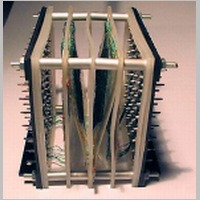Mémoire à tores pour Analyseur multi canaux (?)
(32x32x4)Fr
Ainsi (supposition) avec 2 de ces blocs, on pouvait faire des statistiques sur des pics codés en 10 bits. (comptage de 0 à 255) Avec 4 blocs le comptage se faisait sur 16 bits / 1024 canaux.
US
Thus (assumption) with 2 of these blocks, could make statistics on coded peaks in 10 bits. (counting from 0 to 255). With 4 blocks the counting was done on 16-bit / 1024 channels.
Fr
à traduire...
Si vous avez d'autres informations concernant ce bloc, n'hésitez pas à me contacter!
US
This is the type of memory used before they learned how to manufacture solid state memory. It was the thing that made early computers possible and practical. These cores, when pulsed with sufficient current, will reverse their magnetic polarity. If an equal pulse current is passed through the core in the opposite direction, they will revert to the original polarity. If another wire is passed through the core, it will have an induced current whenever the core switches state (sense line). These are the characteristics that allow information to be read, modified if needed and then written back to memory.
This particular memory was made for a company back in the late '50s (I believe there's a date code of 059 screened on a unit) for use in their nuclear instrument products. It has 4 planes of 1024 cores (32x32x4) or a total of 4096 cores. It has separate sense line and inhibit lines for each plane. It was originally used in the RCL model 20622 pulse height analyzer. I bought up their inventory when I left the company in 1965. These are essentially new, never been soldered to nor used. They're physically quite compact. The stack dimensions are 3”x3”x3/4”. Each X and Y line has both ends on labelled silver plated pins, the sense and inhibit lines are brought out to gold plated tabs on the sides.
Core memories are very costly and it was not too long before silicon memories started winning the new equipment designs. I started designing with cores and made that transition to solid state in the '60s. Core memories are made by hand. It's near impossible to automate their manufacture. Near the end of the era of core usage we were manually putting 4 wires through an inside core diameter of 18 mils. Today I'd be lucky to even see one of those cores. If you're interested, look at a recent eBay sale (190223897904). The seller tells about the fabrication and the economics of these memories.
If you have any questions on this memory (or others) contact me. I had become somewhat of a guru in memory design back then (of course now we'll see how good my memory is).
If you have any further information on this board, do not hesitate to contact me!
|
a 1cab_1.jpg
51.80 KB |
a cf10_1.jpg
73.08 KB |
Fr
(Elles ont subi un léger traitement: dimension, anti-flou...)
US
(They have suffered a slight anti-blur, dimension)
eMail : 2008-09-02
"You are welcome to use anything on this listing that is mine."
Edition originale 2008-09-01
Racine du site
Retour mémoires à tores


